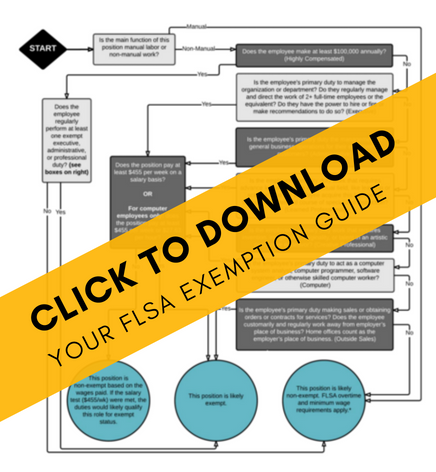
The Fair Labor Standards Act (FLSA) defines the requirements for minimum wage and overtime pay. The act also sets various regulations for recordkeeping and the employment of minors. Affecting most public and private employers, the FLSA can be tricky to navigate – especially when it comes to exemptions. This guide will help you understand the restrictions around employee classifications so you can stay on the Department of Labor’s good side!
What does it mean to be exempt?
An exempt employee is not subject to the minimum wage and overtime provisions of the FLSA. This means the employer doesn’t have to pay the employee a premium for working more than 40 hours in a week. However, it also means the employee’s wages may not be reduced when fewer hours than normal are worked. (Except in limited circumstances.) Although a variety of positions are exempt from the minimum wage and overtime provisions of the FLSA, this guide will focus on White Collar Exemptions.
Factors to Consider
When determining employee classifications, it is not enough to make your decision off of job title alone. Instead, you must look at the actual duties and tasks that make up the majority of the employee’s job. You’ll also have to look at how the employee is paid and how much you are paying them.
State laws can also impact how your employee can be classified. For example, employers in many states (including California, New York, Oregon, and Washington) should be aware that there are some differences between their applicable state’s laws and the federal FLSA. Some exempt roles may not exist under state law or may be much more difficult to meet.
California, in particular, has many exemption criteria that are stricter than the federal requirements outlined here. As a best practice, be sure to always check with an HR Professional or employment attorney regarding additional state regulations before making a final decision.
Understanding FLSA: The Lingo
Before you begin classifying your employees, it’s also important to understand the language used by the FLSA. Knowing the technical definitions below will prove invaluable in the classification process!
Manual Labor or “Blue Collar” Work
Classifications of work involving repetitive operations with the hands, physical skill, and energy of the worker. Employees generally acquire skills and knowledge through apprenticeships and on-the-job training.
Overtime Pay
Overtime pay is a premium payment. Under the FLSA, non-exempt employees must be paid time and a half (1.5x) their regular rate of pay for each hour worked over 40 in a workweek. If an employee works at multiple pay rates throughout the workweek, their regular rate of pay may vary and require additional calculations. This may also be the case if the employee earns commissions or incentive pay.
Keep in mind that some states have their own overtime laws, as well, which expand on the FLSA. (One example of this is daily overtime laws in California.)
Primary Duty
This is the principal, main, major, or most important duty that the employee performs. Determination of an employee’s primary duty must be based on all the facts in a particular case. However, the major emphasis here is on the character of the employee’s job as a whole. Factors to consider include:
- The relative importance of the exempt duties as compared with other types of duties.
- The amount of time spent performing exempt work.
- The employee’s relative freedom from direct supervision.
- The relationship between the employee’s salary and the wages paid to other employees for the kind of non-exempt work performed by the employee. For example, if a shift supervisor only makes 50 cents more than the workers they supervise, their supervisory duties are probably not “primary” enough to qualify them for an exemption.
Salary Basis
Being paid on a salary basis means an employee regularly receives a predetermined amount of compensation per pay period. The employer cannot reduce this predetermined based on the quality or quantity of the employee’s work. Additionally, with few exceptions, an exempt employee must receive their full salary for any week in which they perform any work–regardless of the number of days or hours worked.
Whether the employee works 40 hours or 32, or whether they accomplish 10 things or 3, their compensation will remain the same.
Workweek
The 7-day, 168-hour period that the employer consistently uses to track the number of hours worked to determine if any overtime is due. A commonly used workweek is Sunday at 12:00 am through the following Saturday at midnight.
How do I know if my employee is exempt?
Fortunately, figuring out if your employee can be classified as exempt according to the federal FLSA doesn’t have to be rocket science. Download our handy guide below for a simple question-by-question guide to determining employee classifications, or find it in your HR Support Center!
What Do You Think?
Comment below to share your thoughts on employee classifications! Want more information on the FLSA and how it impacts your business? Join us for our free FLSA Pitfalls webinar to learn about these requirements and how you can avoid the most common FLSA violations. Register today to save your seat!
Disclaimer: Southland Data Processing, Inc. (“SDP”) is not a law firm. The above article is intended for informational purposes only. It should not be relied upon in reaching a conclusion in determining employee classifications. Applicability of the principles above may differ substantially in individual situations. Please consult with your legal counsel or HR advisor prior to making any adjustments to worker classifications. SDP is not responsible for any inadvertent errors that may occur in the application of the FLSA.

